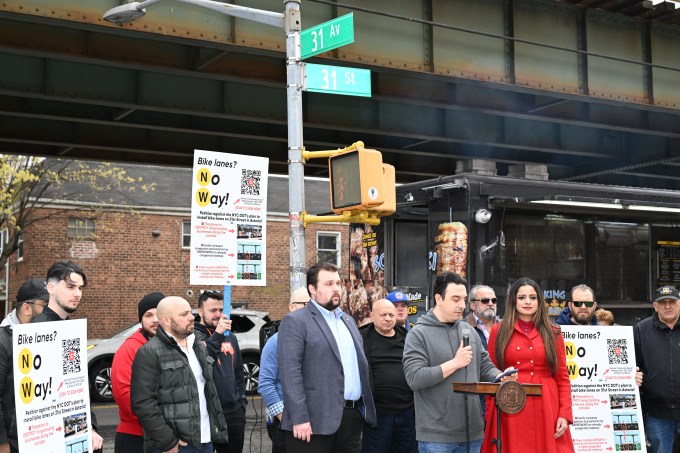
Assembly Member Jenifer Rajkumar joins residents and business owners for a rally against a proposed bike lane along 31st Street. Photo: Ramy Mahmoud.
April 14, 2025 By Shane O’Brien
Assembly Member Jenifer Rajkumar joined a number of Astoria residents and business owners Sunday for a rally against a proposed protected bike lane under the elevated N/W subway tracks on 31st Street.
More than 2,500 people have signed a petition against the bike lane, which would install eight-foot-wide bike lanes on either side of 31st Street from 36th Avenue to Newtown Avenue.
A number of local businesses signed the petition, stating that protected bike lanes would disrupt local businesses, making it more difficult for businesses to take deliveries. They also argue that the proposed bike lanes will force King Souvlaki, a “neighborhood staple” food truck that has served Astoria since 1976, to relocate.
Representatives of several local businesses joined Rajkumar at the intersection of 31st Avenue and 31st Street on Sunday afternoon to protest against the DOT proposal.
Rajkumar, who represents Assembly District 38, including parts of Glendale, Ridgewood and Ozone Park, is a member of the Assembly’s Small Business Committee and said she joined Sunday’s rally to advocate for “smart urban design.”

“I’m here to stand up for the small businesses here on 31st street, including the legendary King Souvlaki. Small businesses are the lifeblood of New York City, and we must make sure that our plans for urban design support our small businesses,” Rajkumar said Sunday.
She said she is a supporter of bike lanes in the city but added that it is “very important” that they are located in the right locations, describing the DOT proposal as an ineffective design.
“The small businesses need to be a part of the discussion. They need to be a part of the process when we make plans. So we all need to come together again with the DOD, to bring the whole community together, to come up with a plan that’s suitable for the entire community,” Rajkumar said, adding that Astoria needs a plan that “works for everyone.”
Joseph Mirabella, a member of the 31st Street Business Association and the organizer of the petition, said the proposal would impact “critical loading zones for businesses.”
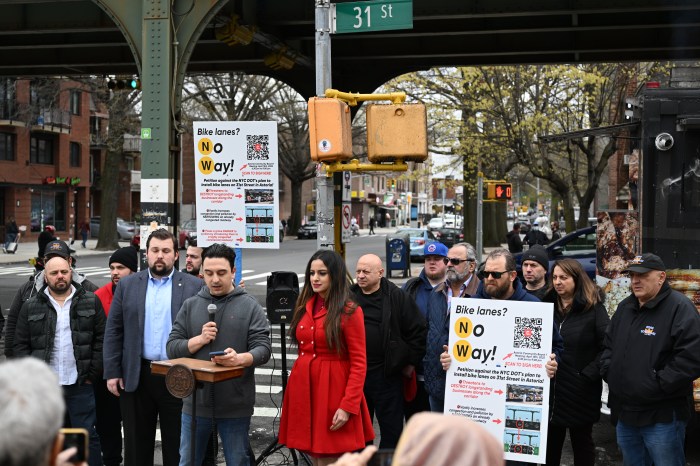
Joseph Mirabella, with the 31st street Business Association. Photo by Ramy Mahmoud
“Intersecting loading zones with bike lanes may cause injuries to cyclists as there are dozens of businesses along 31st street that are industrial, commercial, that rely on loading zones to get equipment, trucks and other duty heavy duty equipment in and out of their businesses,” Mirabella said.
Lampros Tsampas, whose father co-founded the King Souvlaki food truck over 40 years ago, said the business would be forced to relocate if the proposed bike lanes came to pass.

Lampros, Tsampas of King Souvlaki. Photo by Ramy Mahmoud
“They want to make us move from here, and it’s not fair,” Tsampas said. “My family’s been here. My father and my uncle, they’ve been here over 40 years. They worked very hard to build this business to leave to their children.”
Tsampas accused the DOT of informing King Souvlaki that they should simply find a new location.
Other speakers at Sunday’s rally raised concerns about increased congestion in the area, while others said narrowing moving lanes on the street would make it more difficult for ambulances to pass down the street.
Speaking before the rally, Stella Tsikis, an administrator at St. Demetrios Church and School, believes that the addition of a bike lane will make it more dangerous for students crossing the street to get to school. She also said the bike lanes would impact St. Demetrios’ annual festival.
Currently, 31st Street has two 14-foot-wide “moving lanes” inside the 3-foot-wide columns supporting the elevated tracks and two 13-foot-wide parking lanes outside the columns.
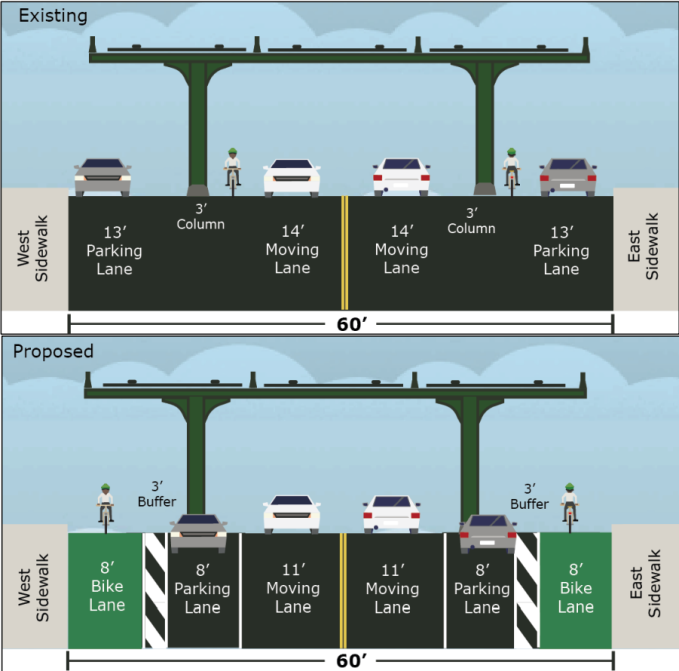
Renderings for proposed bike lanes along 31st Street compared to current layout of the corridor. Photo: DOT
The plan would reduce the width of the moving lanes by three feet in both directions and the width of the parking lanes from 13 feet to 8 feet. The parking lanes would also be relocated from curbside parking to level with the supporting columns, while a 3-foot-wide buffer zone would separate parked cars from the protected bike lanes.
The DOT also plans to add painted pedestrian islands at intersections to shorten pedestrian crossing distances. The plan additionally bans parking at corners to boost visibility.
The DOT argues that protected bike lanes are a necessary step toward reducing serious injuries and fatalities along 31st Street, stating that there were two traffic deaths and 11 serious injuries recorded along the street between 2020 and 2024.
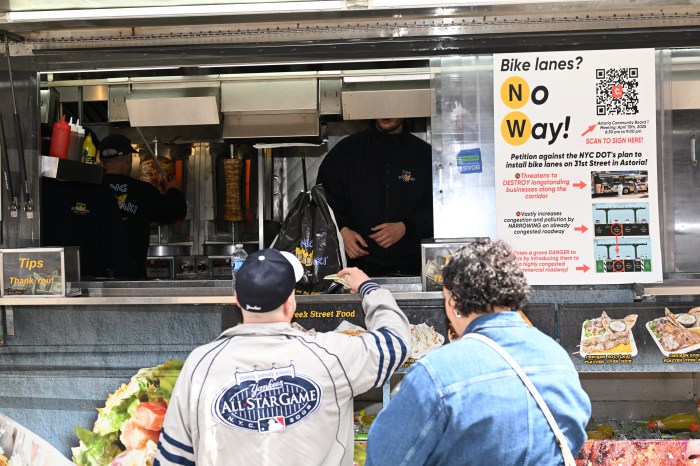
Photo by Ramy Mahmoud
Not everyone agrees with the opposition. Franklin, a resident who lives near 31st Avenue and 32nd Street, said he supports the installation of protected bike lanes along 31st Street.
“I think it’s crazy that so many people are trying to stop bikers from having a safe, dedicated place to ride—on a street they already use,” Franklin said. “The claim that this is about protecting cyclists doesn’t make much sense, especially when even the opponents’ own renderings show cyclists riding right next to cars.”
Franklin also noted that the rally took place near an existing bike lane in front of a thriving business, which he said undermines the argument that protected bike lanes hurt commerce. “This is about safety. Bike lanes make neighborhoods safer, and it’s hard to justify opposing a basic safety measure—especially on a street where cars are constantly double parked and driving erratically,” he said.
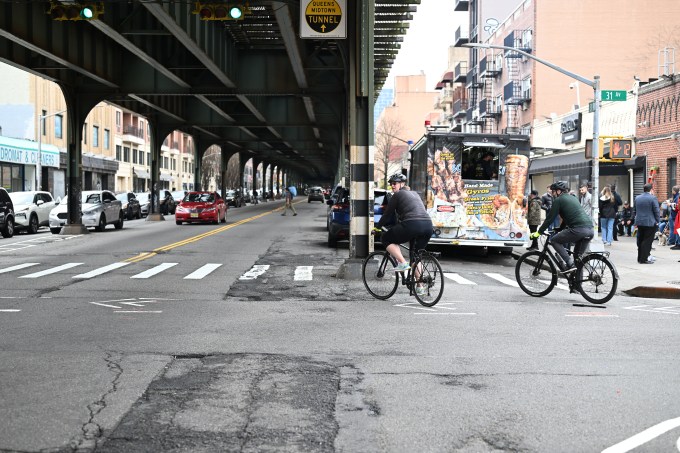
Cyclists along 31st Street. Photo: Ramy Mahmoud.
The mile-long stretch of 31st Street covered by the new bike lane plan is among the most dangerous roads in Queens, according to DOT data, with a total of 178 injuries recorded on the corridor over the four-year period. DOT data cites “multiple instances” of cyclists getting “doored” – referring to when a cyclist collides with a car door that has been opened in their path – while over 30% of pedestrian injuries have been caused by left-turn crashes.
Construction of the protected bike lanes is due to begin in the summer.
DOT officials rebutted the “baseless claims” laid out in the petition, stating that the proposal is a direct result of the Western Queens Street Safety Plan developed by local elected officials. Agency officials also stated that the DOT continues to conduct outreach on all levels to help ensure that local businesses can load goods and receive deliveries.
“Our proposal will better organize traffic on 31st Street, where multiple people have been seriously injured or lost their lives in recent years, to improve safety for everyone while keeping vehicles moving,” a DOT spokesperson said. “This redesign would maintain the existing number of travel and parking lanes—with research showing designs like these successfully improve safety and support local businesses.”
DOT officials additionally stated that existing food trucks on 31st Street would be able to use a “floating parking lane” outlined in the proposal, which would allow them to operate similarly to how they are currently utilizing curbside space.
Officials also noted DOT studies stating that protected bike lanes reduce deaths and injuries for all road users by 16.1%, for pedestrians by 29.2%, and for senior-aged pedestrians by 39%.
